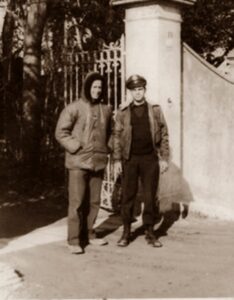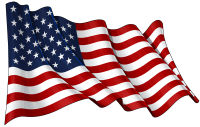WWII & 1940s
Taylorcraft DC-65
First flight was as a U.S. Army Air Force aviation student at the College Training Detachment, Dickinson College, Carlisle PA. Ten hours of dual flight instruction at nearby Wilson Field, New Kingstown PA in April 1943.
Stearman PT-17 “Kaydet”
Primary flight training as an Aviation Cadet, approximately 65 flight hours at Vichy Army Air Base (now Rolla Airport), Vichy MO, and later at the Anderson Air Activities Airfield at McBride, MO in August-September 1943 (now Perryville Regional Airport).
This was the most exciting flying. My buddy, Alan Coles, an experienced pilot, used to keep telling me to turn inside his turns, so as to get the required “lead” on his aircraft for simulated combat. I always did, not knowing that the reason my airplane shuddered and shook was because I was flying at or below stall speed all the time. However, it taught me how to fly the aircraft right to the edge of its performance envelope. We also used to put on acrobatic shows for kids at recess near small schoolhouses in the countryside.
Vultee BT-13A “Valiant”
Basic flight training at Malden Army Airfield (now Malden Regional Airport), Malden MO – approximately 68 flight hours, October – December 1943.
Also used this aircraft as an Instrument Flight Trainer at Pinellas Army Airfield, FL in June 1944.
This was the worst aircraft I ever flew – it needed cross control and was not very stable.
North American AT-6A “Texan”
Advanced Single-Engine Flight Training, approximately 100 flight hours, at Spence Field, Moultrie GA, January – March 1944. Aviation Cadet Graduation, Class 44-B and commissioned 2nd Lieutenant United States Army Air Force on 4 February 1944.
Also flew this AT-6A Texan in ground and aerial gunnery training at Eglin Army Air Force Base, FL, during February – March 1944.
This was a hard airplane to fly – not at all stable and hard to land because the landing gear was so close together.
Curtiss P-40-F, K, N “Warhawk”
P-40-F: 10 flight hours – transition training at Tifton Army Airfield (now Henry Tift Myers Airport), Tifton, GA, March 1944
P-40-K+N: Approximately 85 flight hours of formation, navigation, bombing, and ground & aerial gunnery training at Pinellas Army Airfield (Now St. Pete-Clearwater Intl. Airport), St. Petersburg FL, April – June 1944.
Here I had my first engine failure at about 10,000 feet, some eight miles north of the field. I glided with no engine power to the field, making a perfect approach to the runway and the worst landing ever made by anyone. I did lead the whole class in both aerial and ground gunnery scores. Great airplane!
Douglas RA-24-B “Dauntless”
USAAF version of the Navy SBD Dive-Bomber. The USAAF used this for instrument flight training.
I flew this aircraft from Pinellas Army Airfield, St. Petersburg FL, in June 1944.
Republic P-47-D-22, 23, 26 “Thunderbolt”
Flew this aircraft in combat operations with the 523rd Fighter Bomber Squadron, 27th Fighter Bomber Group, from airfields at Borgo and Serragia, Corsica, Le Luc, Salon-de-Provence, Lyon, and Loyettes Airfields in France.
Approximately 57 combat flight hours, 20 combat missions over Italy and southern France during July – September 1944, including the “D-Day” invasion of southern France (operation Dragoon).
Destroyed several bridges by dive bombing, one German tank, many railway boxcars, some ammo dumps, and many, many German vehicles.
Also demolished one P-47 (mine) by flying through a large tree while strafing vehicles somewhere up the Rhone River Valley.
Also demolished another P-47 (mine) during an armed reconnaissance flight when hit by anti-aircraft fire in the Belfort Gap region of eastern France (near Mancenans). The airplane burned (as did I) but I flew it several miles back toward friendly territory and finally bailed out at about 250 MPH and about 150 feet above the ground. I landed in a plowed field with pretty bad burns and a broken foot. I was picked up “bodily” by a 45th Infantry Division Oklahoma Indian and carried to a medic aid station. Then was evacuated by ambulance, Jeep, and C-47 airplane, finally arriving at the 45th General Hospital, Naples, Italy, where I spent several months.
A War Story: Two American Heros
Donald H. Chaplin, Lt. Col. USAF (RET)
Loyettes Airfieid (near Lyon, France), 12 September 1944, a very sad day for the 27TH Fighter Bomber Group. Fifteen members of the Group perished yesterday in the crash of the Group’s B-25. However, today’s mission duty called and everyone responded.
Led by Capt. Daniel Staehle, eight 523rd Squadron “JUGS” left Loyettes at 0925 on an Armed Reece mission. The other pilots were Lts. John Wright, Robert Rader, Albert Stevens, John Newman, Roy Ruble, Allan Coles and me Donald Chaplin.
Midway between Belfort and Montbeliard, France we encountered intense 20mm and 40mm flak. My aircraft was hit in the fuselage behind the cockpit and started to burn immediately. Capt. Staehle told me to head for home and assigned Lt. Allan Coles to escort me.
I turned westward descending to tree top level with full throttle for the protection that speed and low altitude would afford. My plan was to get over friendly territory then grab some altitude while reducing airspeed for a “textbook” bailout.
“By the book” procedures however were soon abandoned; heat and smoke in the cockpit made seeing and breathing impossible so I opened the canopy. Suddenly the whole right hand cockpit wall disappeared in flame, I was getting burned and I had to get out right now. I leaped straight up, cleared the cockpit and the empennage, and pulled the parachute ripcord. I had just become a member of THE CATERPILLAR CLUB.
I remember a fleeting sensation of floating on air and then one horrific JOLT. I could see nothing but white and then felt cool, soft nylon settle on my face. Clawing away the nylon canopy I was surprised to find that I was flat on the ground with my right leg buried deep in the well tilled earth of a large field. The burning “JUG” was not far away already popping off 50 cal. rounds.
Now we come to the first HERO bit. My buddy, Lt. Allan Francis Coles, saw me hit the ground and realizing that we were still in or very near enemy territory he started to scout the area for hostile forces. Allan saw some soldiers nearby but could not identify them. He then appeared, with gear and flaps down on an approach to my field. I got to my feet and waved him off and thank goodness it worked because his aircraft would have buried itself in that soft earth. On his next pass he identified American GIs in and behind the nearby tree line. He observed the American GI take me from the field and then left the area. Months later I asked Allan why he would even think of trying to land in that field. He replied that he thought I needed help and that maybe he could land, pick me up and take off again or at least help me out of that open field. HE WAS THAT KIND OF MAN.
Now we come to the second HERO bit. As soon as Allan’s JUG pulled away, I saw a man running zig-zag toward me, in a crouch, from the tree line some 75 yards away. I didn’t know he was an American GI so I got out my 45 cal. pistol, tried to cock it and aim it but could not do it even using both hands. He ran up to me said some soothing words, took the pistol right out of my hands, picked me up like a baby and ran in a crouch back to the tree line. there he and another GI put me in a Jeep on a litter and took me to a Btn. aid station.
At the aid station a doctor or medic rapped up my burned arm, hand and legs, gave me a shot of morphine and shipped me off via Jeep and ambulance to a Field Hospital. The next day I was on an Air-evac C-47 to the 45th General Hospital in Naples, Italy.
The GI who picked me up and carried me out of that field was from the 45th Division (Thunderbird), Oklahoma National Guard. I do not know his name did not even get to say “thank you” but I will always remember that he risked his own life to help me. He was my second HERO for the day.
Lt. Allan F. Coles returned to the ZI in Feb 1945 after completing 74 combat missions unscathed and soon returned to his civilian job as a Civilian Pilot Training Instructor. His light aircraft was run down by a Navy R4D (DC-3) and he perished in that mid-air collision.
I recovered enough from my burns and broken bones to be recalled to active duty during the Korean conflict and finally retired after a few more combat missions over the Ho Chi Minh Trail in Laos in 1969.


27th Fighter Bomber Group Reunion 1994
Lt. Col. Chaplin is at top right.

